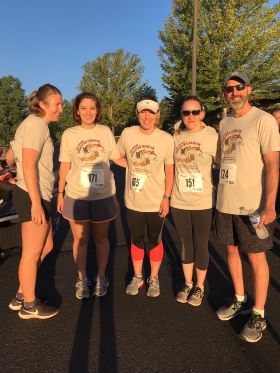Date: 7/26/2019
Author: Charlene Shroulote-Duran
The latest findings and iniatives by faculty, staff, and students affiliated with the Institute for Sustainable Communities (IfSC), the Hazard Reduction Recovery Center (HRRC), and Texas Target Communities (TTC) were presented at the 44th Annual Natural Hazards Research and Applications Workshop held July 14-18 in Broomfield, Colorado. The event drew nearly 600 federal, state, and local emergency management officials, representatives from nonprofit humanitarian organizations, and leading hazards researchers from around the nation and the world.
According to the website, "this year, the Workshop was organized around the theme of Convergence, which refers to the process of people joining forces to respond to pressing challenges and enduring problems. These connections often require the crossing of boundaries, whether they be disciplinary, organizational, geographic, cultural, political, or otherwise. This work can be challenging, but it is also where fundamental breakthroughs in science and application are most likely to occur."
The Workshop kicked off with a meeting of the North Alliance Hazards and Disaster Research Institutes, with plenary sessions held over four days, and two poster events on Sunday and Monday evening. Bright and early Monday morning a welcome session officially opened the Natural Hazards Workshop. This is the time when every participant who is able stands up and says their name and affiliation. Yes, you read that correctly! This is a Workshop tradition that originates in the mission to facilitate connections.
Tuesday, Texas Target Communiites (TTC) hosted an informative and lively session titled, Texas Target Communities--Planning with Purpose, Principles, and Passion. This plenary featured the TTC program, which involves university faculty, students, and community partners who work together with local government officials and community stakeholders to design more just, equitable, and sustainable communities. For 25 years, this program has been helping diverse communities—in rural and urban settings across Texas—develop natural hazard mitigation plans and advance other initiatives. This session highlighted the principles that undergird this program and focused on two communities that have successfully completed the mitigation planning process. Dr. John Cooper and Jaimie Masterson from TTC/IfSC and community partner, Juan Parras, from Texas Environmental Justice Advocacy Services (t.e.j.a.s) were speakers on the panel.
Closing out Tuesday evening, was the annual barbecue, a longstanding and well-attended Workshop tradition. Attendees enjoyed food, beverages, and an amazing view from the Rooftop Terrace and Lounge at the University of Colorado Boulder. This is always a fun and engaging event where faculty, students, and practicioners network and learn more about others in the field and the research they do.
Wednesay began with the 5th Annual Bill Anderson Fund Disaster Dash. The Disaster Dash 5K is an easy jog (or walk) in the beautiful Colorado outdoors. Proceeds from the run support the Bill Anderson Fund mission to expand the number of professionals from historically underrepresented groups in the fields of hazards and disaster research and practice. The Bill Anderson Fund is proud to have begun a Collaborative Communities Initiative in 2018 in which they engage with established civic organizations in marginalized communities to expand their knowledge of impacts and options connected to their sustainability. As is tradition during the closing session, Natural Hazards Center director, Dr. Lori Peek, offered a summary of highlights from the Workshop and a discussion of opportunities for the future.
Wednesday also marked the start of the Researchers Meeting. The Hazards website states, "The Researchers Meeting is organized by the International Sociological Association Research Committee on Disasters and the Natural Hazards Center, with funding support from the National Science Foundation. This annual meeting represents a crucial opportunity for long-time and newly-established members of the community to take stock of what we have learned and where we are heading in hazards research and disaster science. The theme for this years research meeting was Interdisciplinary Research and the Future of Hazards and Disaster Science, with a program designed to identify pressing research needs, examine the experiences of those conducting interdisciplinary research, and foster discussions that approach topics of profound societal importance using an interdisciplinary lens." Faculty, fellows, and students from TAMU's Institute for Sustainable Communities, Hazard Reduction and Recovery Center, and College of Architecture participated in this important event. As co-char, IfSC Community Resilience Discovery Lead and Hazard Reduction and Recovery Center Director, Dr. Michelle Meyer, was instrumental in the organization and execution of the researchers meeting. Scroll down to see some highlights from the event!
Meeting of the North American Alliance of Hazards
and Disaster Research Institutes (photo credit: Chip Van Zandt)
.jpg.aspx)
Dr. Phil Berke, Director, IfSC (photo credit: Chip Van Zandt)

Carlee Purdum, Post-doctoral researcher, HRRC/IfSC
(photo credit: Chip Van Zandt)

Juan Parras, Founder, Texas Environmental Justice
Advocacy Services (t.e.j.a.s) (photo credit: Chip Van Zandt)

(photo credit: Chip Van Zandt)
Plenary: TTC--Planning with Purpose, Principles,
and Planning (photo credit: Chip Van Zandt)
.jpg.aspx)
Dr. John Cooper, Assistant VP for public partnership
and outreach at Texas A&M University (center)
(photo credit: Chip Van Zandt)

Dr. Michelle Meyer (photo credit: Chip Van Zandt)

Dr. Berke at the meeting of the North American
Alliance of Hazardsand Disaster Research Institutes
(photo credit: Chip Van Zandt)

Dr. Shannon Van Zandt, Department Head, Department
of Landscape Architecture & Urban Planning Professor
(photo credit: Chip Van Zandt)

HRRC and the American Planning Association Team
(photo credit: Shannon Van Zandt)

Donghwan Gu, PhD student and researcher
at the HRRC presenting his research at the
poster session. (photo credit Charlene Shroulote-Duran)
.jpg.aspx)
Bill Anderson Disaster Dash 5K fundraiser
Sierra Woodruff, Carlee Purdum, Jaimie Masterson,
Michelle Meyer, and Nathanael Rosenheim (LtoR)
(photo credit Michelle Meyer)

Jaimie Masterson, Associate Director, Texas Target
Communities (TTC) (photo credit: Chip Van Zandt)

Graphic Recording from TTC panel, created by Alece Birnbach
(photo coutesy of Lori Peek)
